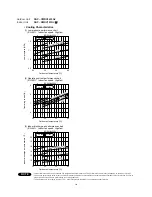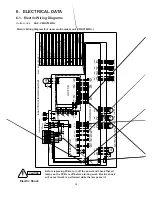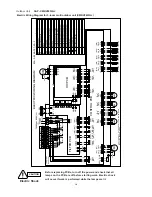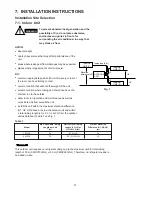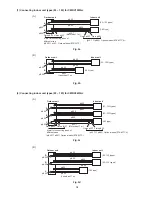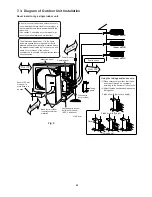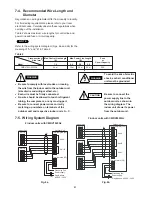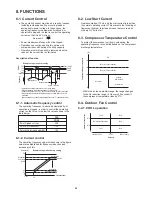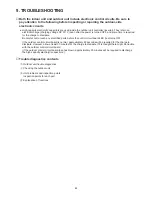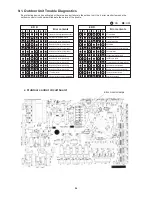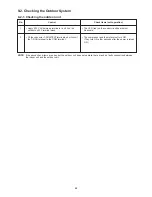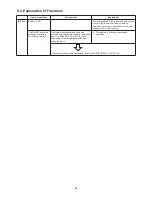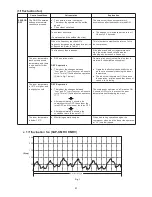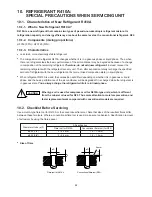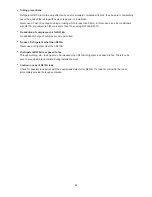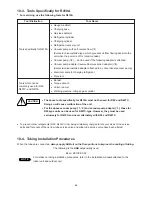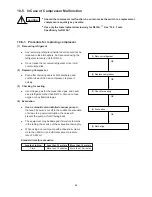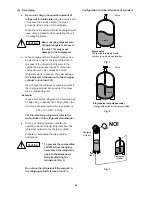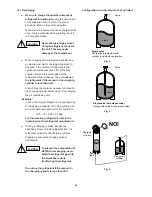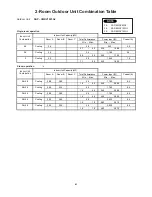
28
9-3-7. Electric expansion valve
●
When replacing the electric expansion valve and coil, be sure to attach the connectors in the correct positions. Labels are
applied to the valve body and coil, corresponding to the connector colors, to identify them.
*
If you have manually checked the electric expansion valve, be sure to reapply the outdoor 220 V after you have replaced the
wiring. (The position of the electric expansion valve will be changed.)
9-3-8. Branch tubing temperature sensor
Check that the sensor is securely contained in the thermostat holder.
9-3-9. Breaker
Check whether or not the breaker has been tripped.
●
Check that the breakers and fuses used are of the specified capacity.
●
Check that the breaker and its line are exclusive for A/C use.
9-3-10. Refrigerant gas pressure
Start a COOL test run, and measure the temperatures of the A/C intake air and discharge air. Compare the values with the
performance charts.
●
If the values are higher than the performance charts:
Check for refrigerant shortage or blockage of the refrigerant circuit.
Assessment of refrigerant shortage:
a
The low-pressure pressure value is 5 MPa or more below the value in the performance charts.
b
There is little condensation on the indoor heat exchanger, which overall appears dry.
Distinguishing between refrigerant shortage and refrigerant circuit blockage:
If the low-pressure pressure does not change when the circuit is charged 2–3 times with refrigerant gas (200 g each time),
or if the change is small, then the problem may not be refrigerant shortage. The problem may be a blockage of the
refrigerant circuit.
●
Check that the electric expansion valve is not blocked. Check as described on the preceding page.
NOTE:
●
Cool the main unit with
a damp cloth or other
means while welding.
●
When applying
vacuum, use the
special service magnet
and rotate at least 5
revolutions
counterclockwise to
fully open the electric
expansion valve.
Use a tester to measure the voltage (12 V).
●
When the power is turned ON, the needle will move from
MMV (white)
→
MVA (black)
→
MVB (red)
→
MVC (blue) in
sequence in approximately 10 – 20 seconds for each point.
(MVC is available only for CMRV2433 model.)
Controller check
No voltage on circuit board
Voltage varies
No temperature change
Temperature changes
0
Ω
Approx. 46
±
4
Ω
Check the coil resistance.
Replace the coil.
Replace the electric
expansion valve.
This part is normal.
Check elsewhere.
Check the illumination
of the red LED.
Check the resistance between the
gray lead wire and the other wires.
Resistance is OK if it is 46
±
4
Ω
at 20
°
C.
Use the special service magnet
and rotate 5 revolutions
clockwise to fully close the valve.
Then start the unit and measure
the temperatures at the inlet and
outlet tubes of the electric
expansion valve. If the
temperature difference is large,
the valve is closed.
Then rotate 5 revolutions
counterclockwise to open the
valve. Operation is normal if the
temperature difference between
the 2 tubes drops.
Replace the controller.
Open and close the
electric expansion valve
by hand to check it.
*

